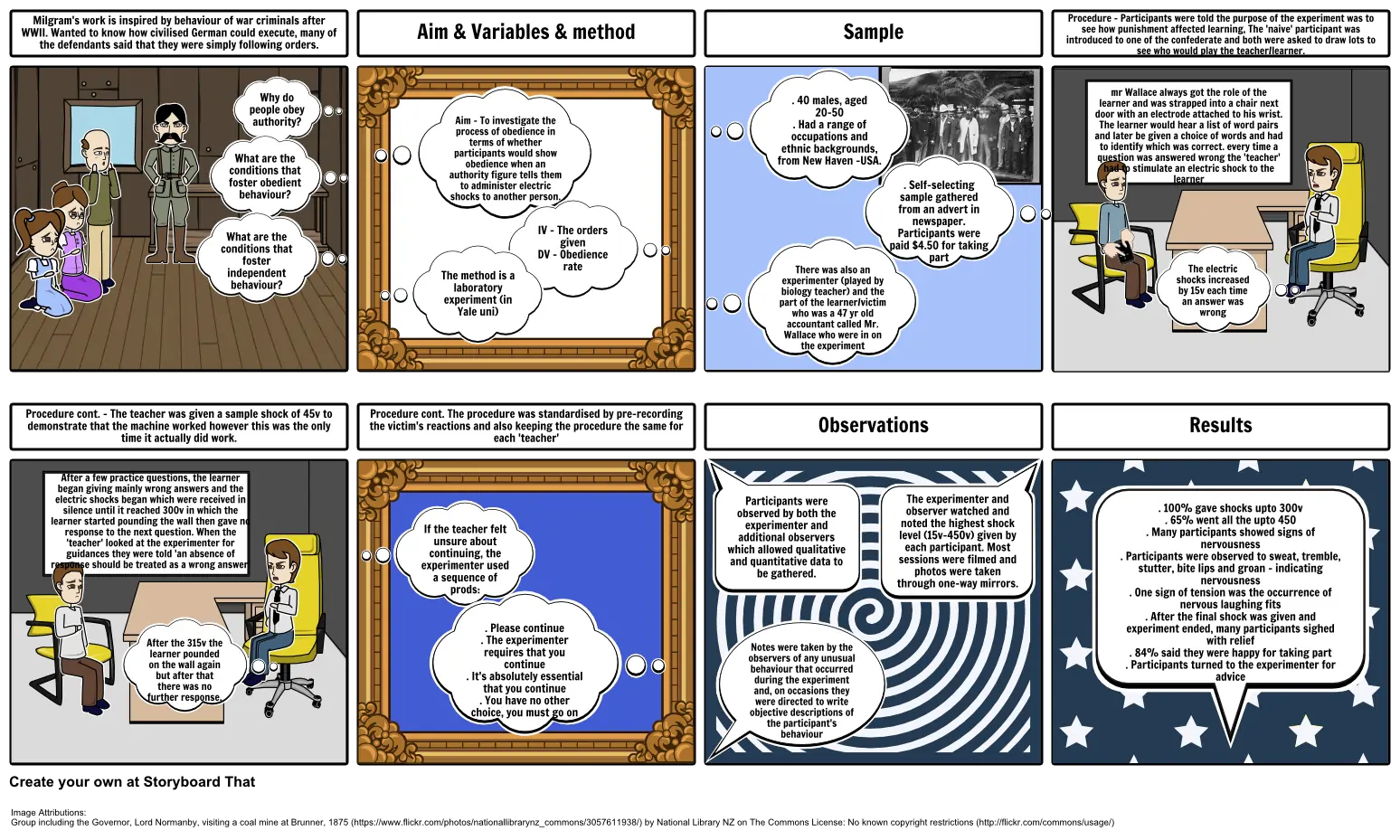Milgram revision resource

نص القصة المصورة
- Milgram's work is inspired by behaviour of war criminals after WWII. Wanted to know how civilised German could execute, many of the defendants said that they were simply following orders.
- What are the conditions that foster independent behaviour?
- What are the conditions that foster obedient behaviour?
- Why do people obey authority?
- Aim & Variables & method
- Aim - To investigate the process of obedience in terms of whether participants would show obedience when an authority figure tells them to administer electric shocks to another person.
- The method is a laboratory experiment (in Yale uni)
- IV - The orders given DV - Obedience rate
- Sample
- There was also an experimenter (played by biology teacher) and the part of the learner/victim who was a 47 yr old accountant called Mr. Wallace who were in on the experiment
- . 40 males, aged 20-50 . Had a range of occupations and ethnic backgrounds, from New Haven -USA.
- . Self-selecting sample gathered from an advert in newspaper. Participants were paid $4.50 for taking part
- Procedure - Participants were told the purpose of the experiment was to see how punishment affected learning, The 'naive' participant was introduced to one of the confederate and both were asked to draw lots to see who would play the teacher/learner.
- mr Wallace always got the role of the learner and was strapped into a chair next door with an electrode attached to his wrist. The learner would hear a list of word pairs and later be given a choice of words and had to identify which was correct. every time a question was answered wrong the 'teacher' had to stimulate an electric shock to the learner
- The electric shocks increased by 15v each time an answer was wrong
- Procedure cont. - The teacher was given a sample shock of 45v to demonstrate that the machine worked however this was the only time it actually did work.
- After a few practice questions, the learner began giving mainly wrong answers and the electric shocks began which were received in silence until it reached 300v in which the learner started pounding the wall then gave no response to the next question. When the 'teacher' looked at the experimenter for guidances they were told 'an absence of response should be treated as a wrong answer'
- After the 315v the learner pounded on the wall again but after that there was no further response.
- Procedure cont. The procedure was standardised by pre-recording the victim's reactions and also keeping the procedure the same for each 'teacher'
- If the teacher felt unsure about continuing, the experimenter used a sequence of prods:
- . Please continue . The experimenter requires that you continue . It's absolutely essential that you continue . You have no other choice, you must go on
- Observations
- Participants were observed by both the experimenter and additional observers which allowed qualitative and quantitative data to be gathered.
- Notes were taken by the observers of any unusual behaviour that occurred during the experiment and, on occasions they were directed to write objective descriptions of the participant's behaviour
- The experimenter and observer watched and noted the highest shock level (15v-450v) given by each participant. Most sessions were filmed and photos were taken through one-way mirrors.
- Results
- . 100% gave shocks upto 300v . 65% went all the upto 450 . Many participants showed signs of nervousness . Participants were observed to sweat, tremble, stutter, bite lips and groan - indicating nervousness . One sign of tension was the occurrence of nervous laughing fits . After the final shock was given and experiment ended, many participants sighed with relief . 84% said they were happy for taking part . Participants turned to the experimenter for advice
المشمولات صورة
- Group including the Governor, Lord Normanby, visiting a coal mine at Brunner, 1875 - National Library NZ on The Commons - (رخصة No known copyright restrictions )
تم إنشاء أكثر من 30 مليون من القصص المصورة

